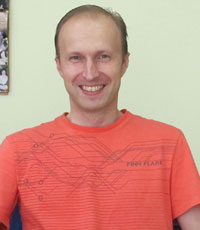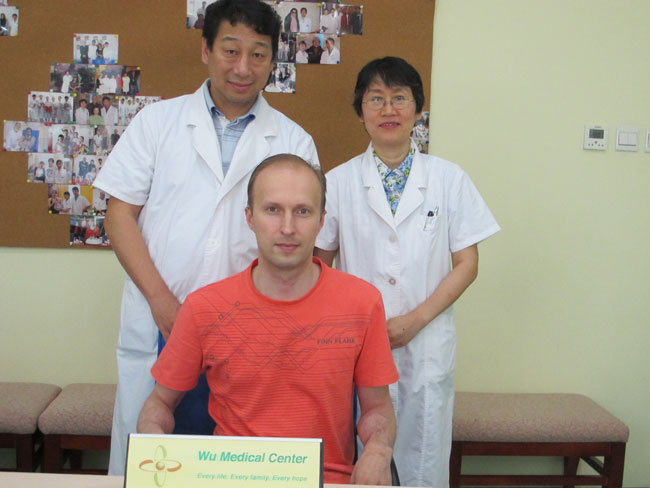Dimitriy Lissitsyn-Multiple Sclerosis-(Kazakhsta)-Posted on July 28, 2014
 Name: Dimitriy Lissitsyn
Name: Dimitriy Lissitsyn
Sex: Male
Country: Kazakhsta
Age:38 years
Diagnoses: Multiple sclerosis, Urinary infection
Date: June 29, 2014
Days Admitted to Hospital: 27 days
Before treatment:
About 14 years ago, the patient suffered from sensory disorders without obvious incentive. His walking ability was not limited. He went to a local hospital and received examination, the results showed no abnormalities. He didn't received any treatment. About 3 weeks later, the symptoms was alleviated. The disease onset 3 times from 2000 to 2005, all of them were alleviated by themselves. The patient again suffered from sensory disorders in 2005. He went to another hospital and was diagnosed with Multiple sclerosis. He was injected betaferon everyday. There was no obvious alleviation after 9 years of treatment. The patient's disease aggravated gradually in recent years, say 3 years. The sensory disorders of both lower limbs was aggravated abnormally. The patient suffered from weakness of both lower limbs and right upper limb. This accompanied with dizziness, balance disorders, constipation, frequent urination and unclearly urination. He also had sexual dysfunction. Before the treatment, the muscle strength of both lower limbs was at level 4. He could walk independently, but the walking gait was unstable. He couldn't stand with single leg. Right hand was not flexible. The patient suffered from frequent urination, and urinate every 1-2 hours. The quantity of urine was less. He had defecation every 4 days.
From the onset of disease, the patient's spirit was good. The sleep and appetite were almost normal. There was no hereditary disease.
Admission PE:
Bp: 109/79mmHg; Hr: 74/min. Temperature: 36 deg. The development and nutrition were normal. The thorax was symmetrical. Through auscultation, there was no moist or dry rales in both lungs. The heart sound was strong, the rhythm of heart was regular, with no obvious murmur in valve auscultation area. The abdomen was flat and soft, with no palpable masses. The laboratory test showed the white blood cells 2+.
Nervous System Examination:
Dimitriy Lissitsyn was alert with good spirit. He speaks fluently. His memory, calculation abilities and orientation were all normal. Both pupils were equal in size and round, the diameter was 3mms. Both pupils reacted normally to light stimulus. There was no visual field defect in both eyes. There was horizontal nystagmus.
The forehead wrinkle pattern was symmetrical. The bilateral nasolabial sulcus was equal in depth. The tongue was centered in the oral cavity and the teeth were shown without deflection. There was no atrophy in the tongue. The uvula was shifted to the left side. The neck could move freely. The muscle tone of his four limbs was normal. The muscle strength of his four limbs was at level 5. The hold power of both hands was at level 5. The muscle strength of left lower limb was at level 4+. The muscle strength of right lower limb was at level 4-. The abdominal reflexes disappeared. The tendon reflex of both upper limbs was almost normal. The tendon reflex of both lower limbs was active. Right side Babinski sign was positive. Right side ankle clonus was positive. Left side Babinski sign was neutral. The pinprick sensation below T4 was low down. The seismesthesia below bilateral sacroiliac joint was low down. He was able to do the finger-to-nose test, fingers coordinate movement and the rapid rotation test in an almost normal manner. He couldn't stand stably. If he closed eyes, he had difficulty with standing when we pushed him. He also had difficulty to stand when he open his eyes. He also had difficulty with walking straight or standing with single leg. There was no meningeal irritation sign.
Treatment:
Dimitriy Lissitsyn received a complete examination after his admission. He was diagnosed with multiple sclerosis and urinary infection. He received treatment for nerve regeneration and to activate stem cells in the body. He was given treatment in order to expand the blood vessels, to improve blood circulation and also improve nourishment of the neurons. He also received treatment to enhance the body's resistance to infection. This was combined with physical rehabilitation training.
Post-treatment:
Urinary infection has been cured. The urine routine is restore to normal. The frequent urination and constipation are alleviated. The frequency of urination has reduced, about 8 to 10 days every day. The patient has defecation every other day. The sensory system below thoracic vertebrae 4 is better than before. There is abdominal reflexes. The ability to stabilize himself in standing position is better than before. He can stand better when he closes eyes, if he was pushed, the patient can keep his balance and does not fall down, and there is reduction in his shaking. With a slight assistance, the patient almost can keep his balance and does not fall down. He can stand with left leg for 20 seconds, but the standing ability with right leg was less than left side.

(Download the Windows Media Player Firefox Plugin if you are using Firefox browser.
To know more,Please read Using the Windows Media Player plugin with Firefox.)
